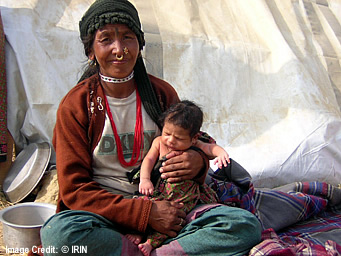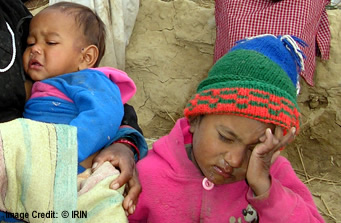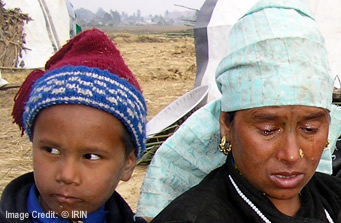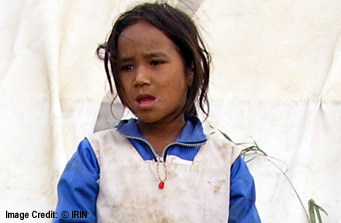|
Nepal
in Crisis 2005: Human Rights
|
|
Global
Overview of Trends and Developments in 2004:
Summary
|
 |
| Internal
displacement: A neglected human tragedy |
 |
Publication
Date: March 2005
Internally
displaced people are among the most vulnerable victims of conflict, and
constitute arguably the largest at-risk population in the world. The abstract
term "internal displacement", created to distinguish IDPs from refugees,
fails to convey the immense human suffering most internally displaced people
are forced to undergo. The act of displacement itself often is accompanied
by violence and the most serious human rights violations such as arbitrary
killings, torture, kidnappings and rape.
 |
<<
Refugees at an IDP camp in Rajhena of Nepalgunj
Traumatised
and fearing for their lives, every year millions of people, most of them
women and children, are forced to leave behind their homes, land and other
belongings to seek refuge in more secure areas.
While
those who manage to flee across an internationally recognised border can
claim protection and assistance under the 1951 refugee convention and can
turn to the UN refugee agency UNHCR for help, no such system exists for
internally displaced people. IDPs remain largely dependent on their governments
who have the primary responsibility to protect and assist them, but often
lack the interest or means to do so. |
|
Consequently,
large numbers of IDPs remain at high risk of further violence, malnutrition
and diseases, and many are forced to flee several times. Without access
to employment, farmable land, social services or even informal support
networks, many IDPs, in particular those living in camps, have to rely
on humanitarian aid to survive.
 |
<<
Bacchu Rokaya's children at an IDP camp in Rajhena of Nepalgunj
But
large numbers of IDPs receive too little or no assistance at all.
The
reasons are manifold: insecurity, natural barriers, lack of donor funds,
coordination problems among aid agencies, corrupted or hostile authorities
complicating access, or lack of information on the whereabouts and living
conditions of IDPs living with host communities rather than in designated
sites. |
|
.
| Internally
Displaced Women |
 |
It
is estimated that women and children comprise between 70 and 80 per cent
of internally displaced populations forced to leave their homes owing to
armed conflict or human rights violations. Yet national and international
IDP policies and strategies still do not reflect this reality.
 |
<<
Refugees in Nepal: Bacchu Rokaya and her son at an IDP camp in Rajhena
of Nepalgunj
A
critical gap in the international response remains the failure to collect
disaggregated data, including registration, statistics and needs assessments,
that reflect age and gender among IDP populations.
This
data is vital to ensure that the needs of women and children are appropriately
addressed from the first stages of displacement displacement to the identification
of durable solutions for return and reintegration or local integration. |
|
| Internally
Displaced Children |
 |
The
Guiding Principles on Internal Displacement specifically recognise that
"children and unaccompanied minors�shall be entitled to protection and
assistance required by their condition and to treatment which takes into
account their special needs". Internally displaced children are among the
most at risk of waraffected children. The process of displacement in itself
puts in danger many of the human rights guaranteed to the child in international
law.
Displacement
frequently results in the breakdown of family and community structures,
the disintegration of traditional and social norms, and an increase in
female-headed households which places displaced children at greater risk
of infringements of their physical integrity and psychosocial well-being,
including death, abuse, malnutrition, poverty, discrimination and other
human rights violations.
In
protracted situations of displacement, internally displaced children may
spend their entire childhood in camps or temporary shelters. Although they
may survive the stage of displacement, internally displaced children encounter
other threats to their well-being during the process of return and reintegration.
For example, displaced children returning home after confl ict are regular
victims of landmines.
 |
<<
Refugees in Nepal: Bacchu Rokaya and her son at an IDP camp in Rajhena
of Nepalgunj
| Conflict-induced
displacement often produces more vulnerable groups of children, such as
unaccompanied children, children in detention, street children and child
soldiers.
For
example, displaced boys and girls, particularly those who have been separated
from parents and family, are more often targets of abduction and forcible
recruitment by rebel groups and paramilitary or government forces. |
|
Many
former child soldiers also become displaced, due the potential dangers
they may face upon return such as re-recruitment and punishment by family
or opposing groups. In addition to military duties, both displaced boys
and girls are vulnerable to rape, sexual exploitation and enslavement,
but girls are principal targets.
Health
and nutrition are the most important indicators to assess the well-being
of a population as well as to measure the severity of the effects of war
or natural disaster. While the vulnerability of IDPs is widely acknowledged,
in most countries no surveys have been carried out to monitor and assess
their nutritional and health status, not even in some of the most serious
humanitarian emergencies such as Burundi, Côte d'Ivoire, DRC, Indonesia
(Aceh), Iraq or Nepal.
In
Nepal, fighting resumed, accompanied by a sharp increase in human rights
violations, after the breakdown of peace talks between the government and
Maoist rebels in August 2003 ended a ceasefire agreed in early 2003. It
is estimated that up to 200,000 people have been displaced since the conflict
started in the mid-1990s.
The
sharp deterioration of the general human rights situation in Nepal prompted
a group of independent experts of the UN Commission on Human Rights to
express their serious concern regarding the situation in the country in
July 2004. In early 2004, it was reported that the government had started
setting up civil defence groups, causing concern among human rights organisations
that this initiative was likely to further polarise Nepalese society and
increase the level of violence. Displaced women and children often faced
particularly difficult conditions. Many children, traumatised by the violence
and destruction they had witnessed, moved to urban or semi-urban areas
with unhygienic living conditions and hostile environments. Some live on
the street, without access to education and exposed to a variety of threats,
including sexual exploitation and forms of child labour. Lack of employment
opportunities in the urban areas has reportedly forced many displaced women
to join the sex business, in particular in Kathmandu.
Similarly,
the only international assistance welcomed by the Nepalese government was
the provision of military equipment and training to its armed forces. The
government has not developed any IDP-specific strategy and has only taken
limited steps to acknowledge the displacement crisis caused by the fighting.
Limited assistance has been provided to those displaced by the Maoists,
but those displaced by the actions of the security forces were not recognised
as IDPs, nor did they qualify for any assistance from the authorities.
In October 2004, the government announced the creation of a relief package
for IDPs, although most observers agree that it cannot be considered as
an appropriate response to the problem of the displaced. The vast majority
of aid agencies were implementing development programmes, without specifically
addressing the emergency assistance needs of IDPs.
|
Facts
|
Facts |
Year
2004 |
|
Fact
1
|
Major
new displacement during 2004 |
Sudan,
Uganda, Colombia, Iraq, Somalia, Nepal |
|
Fact
2
|
Worst
displacement situations |
Burma
(Myanmar), Indonesia, Iraq, Nepal,
Sudan, Uganda
Most
often, however, displacement situations are linked to civil wars typically
pitching one or more rebel groups, often with secessionist or revolutionary
agendas, against the central government or militias backed by the authorities.
This scenario characterises some of the worst displacement situations,
including Sudan, Colombia, Uganda, Nepal and Burma (Myanmar). |
|
Fact
3
|
New
displacements in 2004 |
The
outbreak or intensification of conflicts led to new displacements, in particular
in Nepal,
Indonesia (Aceh, Maluku), Pakistan, Burma (Myanmar)
and to a lesser extent in Afghanistan and the Philippines.
No
major new conflict leading to internal displacement erupted in 2004, but
a number of ongoing civil wars continued or intensified during the course
of the year. Sudan (Darfur and Upper Nile), Uganda, Iraq and Nepal
are among the countries where the security situation deteriorated signifi
cantly and hundreds of thousands of people were newly displaced in 2004. |
|
Fact
4
|
Anti-rebel
military campaigns |
Several
governments continued or intensified anti-rebel military campaigns labelled
"counter-terrorist" operations, which led to new displacements and prevented
return, including in Chechnya (Russian Federation), Aceh (Indonesia),
Colombia, northern Uganda and Nepal. |
|
Fact
5
|
Hostility
or indifference to IDP protection needs |
Countries
where authorities reacted with hostility or indifference to IDP protection
needs: among others Nepal |
|
Fact
6
|
IDPs
did not receive assistance |
Countries
where IDPs did not receive assistance from national authorities:
Clearly,
the protection situation was worst in those countries where the government
itself was a main agent of displacement, as was the case for example in
Sudan,
Burma and Nepal. |
|
Fact
7
|
Displaced
children |
Displaced
children also faced difficulty accessing education due to language barriers
and acute shortages in teachers in some countries, including Iraq, Nepal
and Uganda. |
|
Fact
8
|
Recruitment
and participation of children in armed conflict |
Though
international law prohibits the recruitment and participation of children
in armed conflict, these practices continued in numerous countries.
In
2004, countries where displaced children continued to be drawn into armed
conflict by military groups included Burundi, Colombia, Côte d'Ivoire,
DRC, Indonesia, Liberia, Nepal,
the Philippines, Sudan and Uganda.
Forced
recruitment continued also to be a signifi ant cause of displacement among
children, including in Uganda, Burma (Myanmar), Nepal
and Sri Lanka. |

|
|
Refugees
in Nepal: Bacchu Rokaya and her children at an IDP camp in Rajhena of Nepalgunj
|
Credit:
Global IDP Project
Norwegian
Refugee Council, Chemin de Balexert 7-9CH-1219 Châtelaine (Geneva),
Switzerland
.

|








